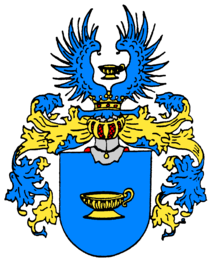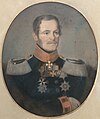Rauch (noble family)
Rauch is the name of a noble Prussian family that goes back to Major General Bonaventura von Rauch .
history
The noble Prussian family Rauch begins with Major General Bonaventura von Rauch (1740–1814).
The ancestor of the Prussian Rauch grew up as an orphan in the Upper Bavarian Peterskirchen near Altötting , in Straubing , Dresden and Bayreuth . In 1756, Duke Karl I of Braunschweig-Wolfenbüttel took him into his service, first as a page and later as an engineer officer. On the recommendation of Field Marshal Duke Ferdinand von Braunschweig and with personal instructions from King Frederick the Great , Bonaventure von Rauch joined the Prussian army in 1777. Since then, he and his descendants carry the title of nobility without objection. In 1857 and 1879 the brothers Adalbert von Rauch, kk Oberleutnant, and Franz von Rauch, kk Rittmeister i. R., the Prussian nobility certificate issued. The Department for Nobility Issues in Berlin confirmed the Prussian Rauch's non-objection to their aristocratic leadership with a resolution of February 5, 1927.
Until the end of the monarchy in Germany, the majority of the sons of the Rauch family served as officers. Bonaventura von Rauch and three of his sons began their military careers in the Prussian engineering corps as the most modern weapon at the time . His two youngest sons Friedrich Wilhelm von Rauch and Albert von Rauch switched to the traditional 1st Guards Regiment on foot . The sons of the following Rauch generations almost exclusively joined the 1st Guard Regiment, the Regiment of the Gardes du Corps , other guard regiments and the traditional regiments of the cavalry. Many officers of the Prussian Rauch were employed in the general staff and rose as generals and colonels in top military posts, above all the army reformer Gustav von Rauch as Prussian war minister and general of the infantry . In memory of this minister and general, the Pioneer Battalion von Rauch (1st Brandenburg) No. 3 received his honorary name. It was stationed in Torgau , later in (Berlin-) Spandau and Brandenburg an der Havel .

Following their officer service, a number of sons of the Rauch family worked in leading positions at the court of the Prussian kings and German emperors as well as at the courts of family members of the ruling Hohenzollerns in Berlin, Plön and Karlsruhe . Likewise, many of Rauch's daughters and married wives worked as court ladies at the courts of the Hohenzollern and their family members in Berlin, Potsdam , Schwerin , Neustrelitz , Meiningen and Saint Petersburg . Other female family members were active in the church and social sectors for a long time.
Since 1788 the cities of Berlin and Potsdam have been the center of life for many members of the Rauch family. Minister and General of the Infantry Gustav von Rauch became the 16th honorary citizen of Berlin in 1840 . In 2005, the Senate Department of the State of Berlin rebuilt the Gustav von Rauchs grave of honor in the Invalidenfriedhof .
With the Austro-Hungarian Major Franz von Rauch (1828–1911) and his brother, the Austro-Hungarian Colonel Adalbert von Rauch (1829–1907), a Bohemian branch of the Rauch family was formed. It went out in 1946.
In addition to the Prussian noble family Rauch, there were and still exist a number of other noble families of the same name, such as the von Rauch family from Lippe-Detmold, the von Rauch family from Württemberg (1808), the Russian-Baltic von Rauch family, the de Rauch family who immigrated to France and Great Britain , the Croatian family Rauch von Nyek and in Austria the families Rauch von Montpredil and Rauch von Rauchberg. A tribal or coat of arms relationship among these noble families of the same name has not yet been proven.
Possessions
The Prussian Rauch family had no ancestral possessions.
Franz von Rauch inherited from his mother's younger sister Amélie nee. von Levetzow , Bertha Baroness Mladota von Solopisk born von Levetzow (1808–1839), in Northern Bohemia the Netluk (Pnětluky) estate near Aussig (Ústí nad Labem). A brother Adalbert von Rauch received from the inheritance of his mother's older sister, Ulrike von Levetzow , the Trziblitz (Třebívlice) estate in the Litoměřice district . He and his children secured Ulrike von Levetzow's estate and memories of Johann Wolfgang von Goethe's encounters with her and her family. The Trziblitz estate was sold to the city of Brüx ( Most ) in 1901 .
Elisabeth von Storch née von Rauch (1893–1973), daughter of the general of the cavalry Friedrich von Rauch and his first wife Anna née von Behr , inherited the Schmoldow manor near Greifswald from her mother in 1896 . As the owner of Schmoldow, she was expropriated without compensation in 1945.
coat of arms
The coat of arms of the Prussian Rauch family shows a golden handle shell in blue. On the helmet with blue and gold covers, the golden handle shell is repeated between open blue flights. The handle bowl can be interpreted as a smoke bowl . Then it would be a talking coat of arms .
The Rauch coat of arms essentially corresponds to that of the Scheler family (historically also: Schäler , (von) Scheller (on Erekheimb and Lerchenberg ) and Scheler vom Lerchenberg ), a patrician family who had lived in Ulm since the early 15th century and later also in Ravensburg and Augsburg . The branch of the Scheler von Erkheim (Scheller von Erkheim) also led it in the four-sided coat of arms. The Scheler branch, which in 1727 was granted imperial nobility and later the Württemberg count, led the shield image to a stalked rose, as was the Scheler von Ungershausen branch (Scheller von Unger (s )hausen) as a flower in a ring misunderstood a cord. A tribal relationship between the Rauch and Scheler families has not yet been proven. Whether this is due to the conceptual approach to the "talking coat of arms" (smoke bowl: suitable for Rauch or bowl-peeler-Scheler) only a coincidental resemblance to the coat of arms, or if not, how it was transferred from the Scheler to the Prussian coat of arms Smoke has come has not yet been clarified.
Known family members
- Adolf von Rauch (1805–1877), chamberlain , Prussian major in the regiment of the Gardes du Corps and chairman of the Numismatic Society in Berlin
- Albert von Rauch (1829–1901), Prussian general of the infantry and chief of the rural gendarmerie
- Alfred Bonaventura von Rauch (1824–1900), Prussian general of the cavalry , adjutant general of the German emperors and founder of the Berlin army steeplechase
- Bonaventura von Rauch (1740–1814), Prussian major general and director of the engineering academy
- Egmont von Rauch (1829–1875), Prussian colonel and commander of the Hussar Regiment "von Zieten" (Brandenburg) No. 3 , founder of the Saxon-Thuringian riding and horse breeding association and the horse races in Halle (Saale)
- Fedor von Rauch (1822–1892), head stable master of the German Emperors, real secret council , vice-president of the Union Club
- Friedrich von Rauch (1855–1935), Prussian general of the cavalry and inspector of the 1st cavalry inspection
- Friedrich Wilhelm von Rauch (1790–1850), Prussian lieutenant general, adjutant general of King Friedrich Wilhelm IV and military representative in Saint Petersburg
- Friedrich Wilhelm von Rauch (1827–1907), Prussian lieutenant general and commander of the 14th Cavalry Brigade
- Friedrich Wilhelm von Rauch (1868–1899), first lieutenant à la suite of the 1st Guards Regiment on foot, military governor and educator of the sons of Kaiser Wilhelm II . and Empress Auguste Viktorias
- Gustav von Rauch (1774–1841), Prussian infantry general, war minister and honorary citizen of Berlin
- Gustav Waldemar von Rauch (1819–1890), Prussian general of the cavalry and chief of the rural gendarmerie
- Leopold von Rauch (1787–1860), Prussian major general and director of the General War School
- Ludovica Baroness von Stumm-Ramholz, born von Rauch (1866–1945), founder of the hospital building in Schlüchtern
- Nikolaus von Rauch (1851–1904), Prussian colonel and commander of the 29th Cavalry Brigade
- Rosalie Countess von Hohenau née von Rauch (1820–1879), first lady-in-waiting to Princess Marianne of Prussia , then second wife of Prince Albrecht of Prussia
Hereditary burial at the Berlin Invalidenfriedhof
Honorary grave of Minister and General of the Infantry Gustav von Rauch (2013)
Grave monument for Lieutenant General Friedrich Wilhelm von Rauch, center back aedicula (2013)
Grave cross for First Lieutenant Friedrich Wilhelm von Rauch, military governor in the Prinzenhaus Plön (2019)
His younger brother Lieutenant General Friedrich Wilhelm von Rauch, adjutant general of King Friedrich Wilhelm IV and authorized military representative in Saint Petersburg, was buried in front of the grave of honor Gustav von Rauch in Berlin's Invalidenfriedhof . As a foundation of the Prussian King and based on a design by Friedrich August Stüler - possibly with the participation of Friedrich Wilhelm IV - a burial place was created in which, in addition to Friedrich Wilhelm von Rauch, his wife Laurette, née Countess von Moltke from the Wolde family , two of their children and a number of other Rauch's generals and their wives were buried. Between 1850 and 1950, family members from a total of four generations found their final resting place here.
The hereditary burial of the Prussian Rauch, only a few meters away from the former Berlin Wall , has been preserved and was extensively restored after 1990. The graves of other family members in the Berlin Invalidenfriedhof no longer exist.
literature
- Leopold von Zedlitz-Neukirch : New Prussian Nobility Lexicon . Volume 4, 1837, p. 88.
- Ernst Heinrich Kneschke : New general German nobility lexicon . Volume 7, 1867. p. 358.
- Brno genealogical paperback of knight and noble families. 1870-1894.
- Adelslexikon in the series Genealogisches Handbuch des Adels . Volumes XI and XII, 2000/2001. P. 192 and p. 367.
- Gothaisches Noble Paperback B 1928 . (older genealogy) and 1939. p. 468ff.
- Genealogical manual of the nobility . Volumes B VII (1965), p. 335 ff, and B XXI (1995). P. 434ff.
- Heinrich Banniza von Bazan, Richard Müller: German History in Ahnentafeln 2. 1942. S. 132ff.
- J. Schott: The family v. Rauch in the Prussian Army. In: Military weekly paper . No. 79, 1893. pp. 1979ff.
- Laurenz Demps : Between Mars and Minerva. Signpost for the Invalidenfriedhof. 1998. p. 124ff.
- Georg Dehio : Handbook of the German art monuments. Volume Berlin, Berlin, 2nd edition, 2000. p. 147.
- Eva Börsch-Supan , Dietrich Müller-Stüler , ed. from the Berlin State Monument Office : Friedrich August Stüler 1800–1865. Deutscher Kunstverlag, Berlin 1997. p. 973.
- Birgit Fleischmann: The honorary citizens of Berlin. 1993. pp. 38f.
- René Wiese (ed.): Vormärz and Revolution. The diaries of Grand Duke Friedrich Franz II of Mecklenburg-Schwerin. Böhlau Verlag, Cologne Weimar Vienna 2014. pp. 225–227.
Archival material
- Rauch family. The entire offspring of Bonaventura and Johanna von Rauch. Handwritten manuscript by Colonel a. D. Leopold von Rauch, 1945 ( German Aristocratic Archive Marburg)
Web links
Individual evidence
- ^ Diocese of Augsburg: Church of the Assumption of Mary (Erkheim) : parish church
- ^ Paul von Stetten : History of the noble families in the free imperial city of Augsburg , Augsburg 1762, p. 304 f. and coats of arms: Tab. XI., 14.A. and 14.B.
- ^ Friedrich Cast : Süddeutscher Adelsheros or History and Genealogy , Volume 1, Stuttgart 1844, p. 463 f.
- ↑ Foundation Seeau: Scheler of Ungerhausen .
- ↑ 100 years of the hospital in Schlüchtern on osthessen-news.de
























